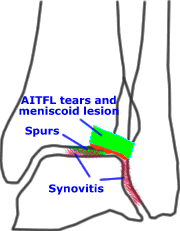History
Patients generally complain of anterior ankle pain which may be more or less localised to the lateral or (less commonly) medial side. There is usually a history of trauma. The patient may complain of giving way, locking or catching in the ankle; sometimes these mechanical symptoms are more troublesome than the pain. Ask about previous ankle problems, problems with other joints and other medical problems.

Palpate the main sources of impingement pain
Examination
There may be an effusion or synovitis. There may be tenderness in the joint line, especially anterolaterally or in the lateral gutter, but this may only be provoked by moving the ankle. Tenderness is often found over the syndesmosis or lateral ankle ligaments. Ankle dorsiflexion is often reduced, although this may be only by a few degrees compared with the other side. A few patients have both anterior and posterior symptoms.
It is important to carefully examine the anterior extra-articular soft tissues, expecially the dorsiflexor tendons - Haller (2006) found extra-articular causes of anterior ankle pain in 17% of their patients.
The cardinal physical sign is the Molloy-Bendall impingement test. The ankle is dorsiflexed with finger pressure in the joint line. The appearance or increase of pain under the finger is a positive test. The test may have to be repeated at different points on the joint line. Molloy et al(2003) found that this test had a sensitivity of 95% and a specificity of 88% to predict synovitis and hypertrophy.
An injection of lignocaine into the area of maximum tenderness will usually reduce or abolish pain.
As the primary management of ankle impingement is normally in the hands of the physiotherapist rather than the surgeon, all of our referrals with post-traumatic ankle problems, including impingement, are primarily assessed by the physio and referred to the surgical clinic only if intervention is planned.

